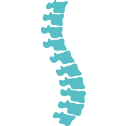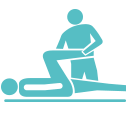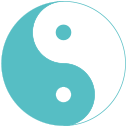Neck Pain | Chiropractic | Ravenswood Chiropractic
Neck Pain
Neck Pain
Approximately 30% of the U.S. population suffers from neck pain, which is one of the most prevalent conditions we treat.
The neck is a unique part of the spine that relies heavily on muscles for stabilization. For many of us, these muscles are strong, which is critically important to carry the weight of your head all day because it weighs about 10 lbs.
When we demonstrate correct posture, our spine can carry this weight evenly over the entire vertebrae, including the disc and facet joints. However, when we demonstrate poor posture, our neck muscles do all the work on their own, with no other aid or support. This is what often occurs from excessive bouts of sitting while hunched over in front of a computer.
Imagine carrying a 10-lb. bowling ball around all day with your arms outstretched in front of you. How do you think your shoulders would feel? There’s no doubt your muscles would be sore, to put it mildly.
Well, your neck can feel these same effects. It can be exacerbated when you hold your head out in front of your body, instead of letting it rest evenly on top of your neck.
This chronic postural achiness and stiffness is the majority of what we see in our office, followed by whiplash-induced neck pain.
The downside of postural stiffness is that it causes muscle spasms, which in turn adds stress to the vertebrae and joints of the neck. Restrictions in the joints then follow, and the full range of motion of the neck is compromised. Do you see how the snowball effect occurs?
This chain of events is frequently involved with pain development in the upper extremities (like the neck). Plus, this is a leading cause of cervicogenic headaches, earaches, and facial pain.
The immediate causes of neck pain could include one or more of the following: pressure, compression, inflammation or irritation of the pain-sensitive nerve endings. These phenomena may be due to muscle tightness, and in some cases can even be caused by a disc injury.
Other common types of neck pain we see in our office are caused by osteoarthritis and torticollis. Torticollis is a condition marked by difficulty and neck pain while turning your head.
Causes of Neck Pain
Although poor posture including rounded shoulders and text neck is one of the leading causes of neck pain, it’s not the only one. Here are a few others that we frequently see in our office:
• Sudden trauma
• Sports injury
• Car accident
• Degenerative conditions
Contributing Risk Factors of Neck Pain
There are also a series of risk factors that are associated with neck pain, which include:
• Poor posture, which we mentioned above.
• Obesity
• Smoking
• Repetitive lifting
• Office and computer work
• Athletic activity
Symptoms Associated with Neck Pain
The symptoms of neck pain can range from mild to severe. In some cases, sufferers might have more than one of these. Here is a list of the most common ones we see:
• Inability to bend or rotate the neck (Difficulty looking up, down, or over your shoulder)
• Weakness in your arms or shoulder muscles
• Muscle spasms
• Radiculopathy (pain and or numbness and tingling in your neck, arm/hands, upper back, shoulders) This could occur in one or both sides.
• Increased pain when coughing, sneezing, reaching or sitting
• Inability to stand or sit up straight
• Stiffness when trying to move
• Tight muscles
• Headaches (cervicogenic | tension
• Pain that is worse in the morning or at night
• Difficulty sleeping due to pain
Diagnosing the Cause of Your Neck Pain
When you first come to the office, we will start out by asking you some questions about the history and onset of your symptoms. We’ll then perform a physical exam, including checking your postural range of motion (ROM) and an examination of your spinal curvature and alignment, muscle tone, spasms and trigger points.
Additional physical and neurological exams that include evaluating reflexes, muscle strength, and a determination if you have experienced any nerve changes are absolutely necessary.
In some instances, X-rays, an MRI, CT or CAT scan might be requested. If nerve damage is present or suspected, an EMG may be conducted to see how much, if any, damage there is.
We like to take a conservative approach at first when it comes to your treatment plan, but we do work with other pain management specialists and surgeons for our most severe cases. Rarely does one of our patients need a pain management specialist or surgical referral. Many of our conservative care tools can also be used at home to promote healing or control pain.
Choosing Safe, Effective Conservative Care for Neck Pain Starts Here
Time and again clinical research is demonstrating that a conservative multidisciplinary approach such as what Ravenswood Chiropractic offers, including chiropractic, massage, physical therapy and acupuncture to treat neck pain has better patient outcomes and satisfaction then medication alone. Choosing conservative chiropractic care for the treatment of neck pain is also less expensive than care initiated by a medical doctor. Additionally, there is a much lower risk of adverse side effects compared to taking aspirin (25x higher risk of adverse effect) or cervical spine surgery (500x higher risk of adverse effect).
Chiropractic Care for Neck Pain
 The neck has seven cervical vertebrae.
The neck has seven cervical vertebrae.
Injuries to the neck such as whiplash can occur during accidents or sports.
There are also degenerative disorders that can creep up like osteoarthritis, spinal stenosis, degenerative disc disease, postural distortions and poor posture.
This is where chiropractic care comes in. One of the essential treatments utilized in these situations is neck adjustments. They help restore the normal function and range of motion of your cervical spine, which in turn reduces pain, soreness, and stiffness.
Spinal Manipulation Safety
People dealing with neck pain are sometimes concerned with the safety of chiropractic adjustments when they seek treatment; however, the clinical research shows that adjustments are both safe and effective when done by a trained professional – and that is just who we have on staff.
Most of the concern revolves around spinal manipulative therapy raising the risk of stroke in older adults. This information is unfounded and no more prevalent than when older adults go to a primary care physician.
In fact, according to the International Chiropractors Association, reports show that statistical evidence varies from 1 case in every 400,000 to 1 in every 5.6 million people treated.
Plus, not a single case of stroke was cited during a study involving approximately 5 million cervical manipulations from 1965 to 1980 at the National College of Chiropractic Clinic in Chicago.
Lastly, the American Chiropractic Association claims that you have a better chance of getting into a car accident on your way to an appointment then you do suffering an injury during an adjustment.
There is nothing wrong with being cautious. But there is also no reason to believe evidence if it does not appear realistic.
If for some reason you do not want your neck adjusted just let us know, there are many other tools we can use to help you feel better.
Physical Therapy for Neck Pain
 It’s essential to stretch tight muscles and strengthen the weakened muscles that support the neck when you have pain or complications. Our team coaches you on an individualized treatment plan that includes a range of exercises that support the neck and expedite the healing process.
It’s essential to stretch tight muscles and strengthen the weakened muscles that support the neck when you have pain or complications. Our team coaches you on an individualized treatment plan that includes a range of exercises that support the neck and expedite the healing process.
We do this in our office, so you can continue your therapy from the comfort of your home. Our goal is for you learn how to improve your posture, ROM, flexibility, and stability.
Hot and Cold Therapies
Both hot and cold therapies have specific benefits when it comes to treating pain and stiffness.
Heat increases blood flow and oxygen to the area that’s affected, which helps promote faster healing.
Cold reduces inflammation and pain, which also speeds the healing process.
In some cases, hot and cold therapies are used in an alternating fashion, which can cause a synergistic effect.
We will instruct you how and when to use each one during different phases of your treatment plan.
Electrotherapy
Pain signals are transported from an area of the body to the brain by way of nerve endings. With electrotherapy, we utilize small waves of electric signals to block pain pathways and also help reduce muscles spasms.
Ultrasound
When you first see the word “ultrasound,” you might think in terms of medical imaging. It’s true that it’s used for this, however, you can also use ultrasound waves therapeutically as we do.
It’s effective for increasing blood circulation, relieving spasms, and reducing swelling, stiffness, pain, and inflammation.
Our ultimate goal is to get you out of pain and keep you out of pain. We’ll do this by helping you break poor posture habits and analyzing your home and work environments. This gives us feedback on how you can protect yourself from neck pain and not re-injure yourself.
In The Big Picture:
Research shows that physical medicine is a better treatment than surgery or pain medication for neck pain in most situations. The best-case scenario is you may entirely avoid the need for surgery or medicine altogether.
Activity modification is an essential aspect of avoiding painful situations. We’ll come up with a game plan that teaches you how to sit, sleep, and do daily living activities more efficiently.
Our physical therapy team will help you stay active around the house and avoid prolonged rest, which can be counterproductive. It is best to go on short walks several times a day to decrease pain and stiffness to help you feel better.
The general goals are to avoid surgery and medication and improve posture, mobility, flexibility, strength, and endurance. Then you will be able to resume doing the activities you love on a daily basis.
We also work with those who have had surgery, as well as their surgeon to regain motion and strength quickly.
Massage for Neck Pain
 Muscle adhesions and strains are common conditions that a lot of people experience on a daily basis. Although not life-threatening, they can cut into your quality of life.
Muscle adhesions and strains are common conditions that a lot of people experience on a daily basis. Although not life-threatening, they can cut into your quality of life.
The good news is, our clinical massage therapists treat these, and many other symptoms related to neck conditions.
If you are suffering from neck pain and are in need of treatment, you may likely have clinical massage therapy in your treatment plan which our chiropractic physician will guide them on what areas to address when it is safe and appropriate to do so.
From a treatment perspective, massage therapists use various strokes to improve circulation and reduce painful muscle spasms, which can increase your Range of Motion.
After trauma, muscle guarding occurs, during which the muscles seize to protect themselves from possible further damage. This is also sometimes referred to as “startle reflex.” In cases like this, massage can help resume normal function.
The myofascia (covering the muscles) is also an area massage therapists work on to reduce adhesions that occur following an injury.
Not only do your symptoms, exam, and feedback tell them about what muscles need work to get better, but they are also feeling for tension, tone, flexibility, and mobility in your neck.
Plus, they are probing for trigger points along the muscles, which gives them further feedback on what’s going on and where the work needs to be done.
Acupuncture for Neck Pain
Acupuncture is a branch of traditional Chinese medicine which originated thousands of years ago in China. It uses ultra-fine needles to stimulate specific points on the skin to balance the body and mind, maintain health and treat disease.
Acupuncture is probably best known as a treatment for pain, and it can help relieve neck pain in some different ways. Here are just a few:
• Relaxes the muscles to reduce tension and relieve spasms
• Triggers the release of endorphins, the body’s natural painkillers
• Reduces local inflammation
• Improves circulation to support faster healing
Another key feature of acupuncture theory is that it views the body and mind as being closely interconnected. Any emotional imbalance can result in physical symptoms and vice versa. Therefore, acupuncture makes an especially suitable treatment if your neck pain is due to stress and muscle tension.
Your acupuncturist may select local points in the painful area or distal points elsewhere on the body. This will depend on your individual symptoms and diagnosis. Points can also be added to relieve other symptoms such as stress or headaches if necessary.
When you come for your first acupuncture treatment, we carry out a thorough consultation, asking about your symptoms, medical history and lifestyle. This allows us to build up a detailed picture of how your body is functioning and create an individualized treatment plan to address your specific needs.
Call Today
Pain lasting more than a week is not normal and not good. Don’t delay your treatment. Safe, drug-free treatment options are available and effective. Speak to one of our expert team members today at 773.878.7330 or request your appointment online.











